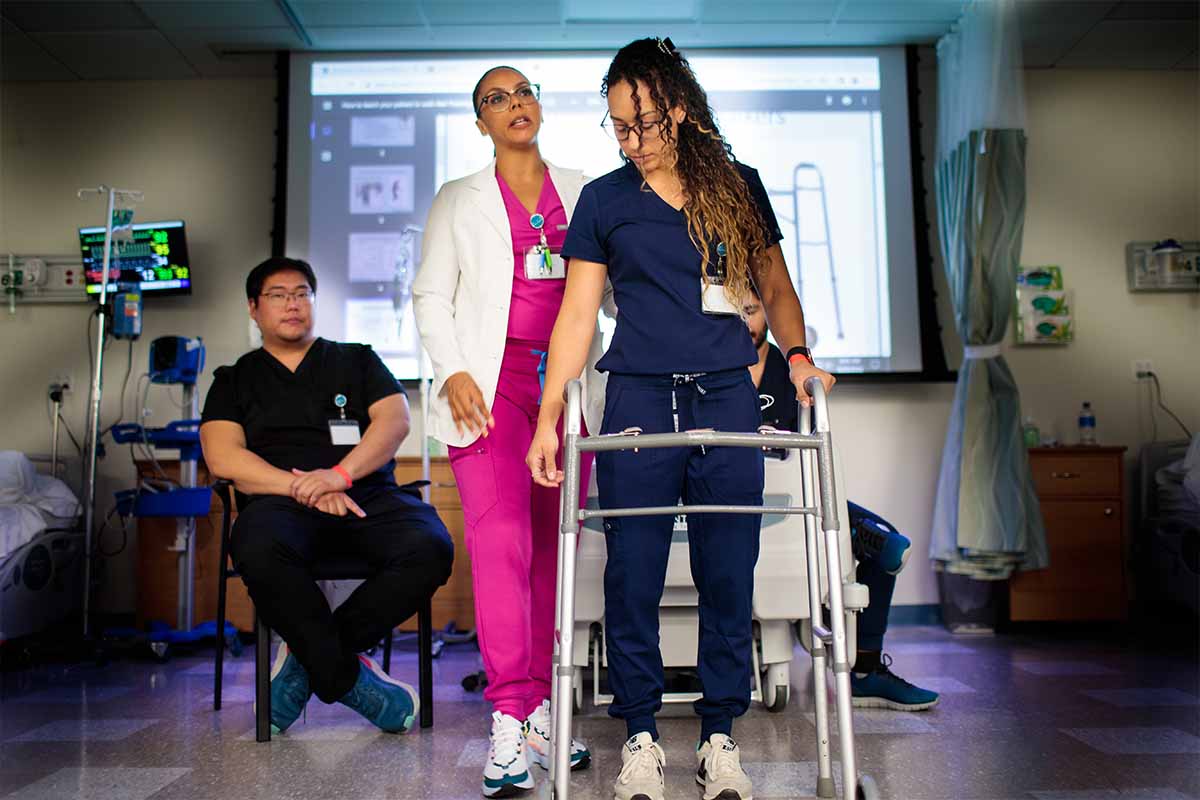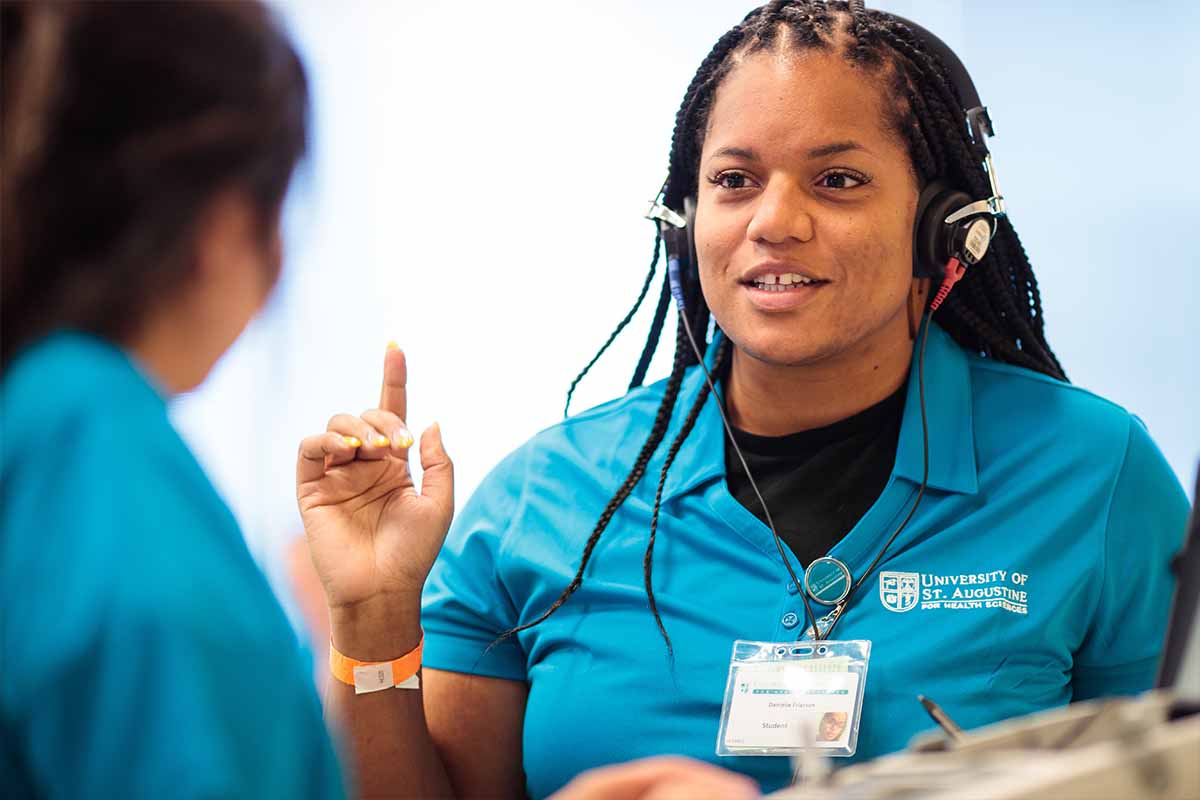
Sheila Prose, a professor and supervisor at the pro bono neuroplasticity clinic at the University of St. Augustine for Health Sciences in South Austin, holds onto Oray Dill as he works with student Savannah Wisnieski.
Originally published on Austin American-Statesman
Six-year-old Oray Dill giggles with delight as Savannah Wisnieski turns a fabric tunnel into a worm that’s going to swallow him up.
For three years, Oray came to the physical therapy space on the campus of the University of St. Augustine for Health Sciences (USAHS) in the Circle C area of far South Austin and worked with university students like Wisnieski. The campus has degree programs for physical therapy, occupational therapy and speech language pathology.
Oray, who was born with cerebral palsy, has been part of the university’s pro bono neuroplasticity clinic, which began in 2019 and continues to provide intensive therapy 90 minutes a day, five days a week for kids with cerebral palsy who are either uninsured or underinsured.
It gives the children access to equipment many physical therapy spaces don’t have, such as a gait-training treadmill that supports the weight of the kids while they learn to walk.
“It gives them the chance to practice their gait without a fear of falling,” said Sheila Brose, a USAHS physical therapy professor who supervises the students in the program.
They also use a vibrating platform that helps open the connection between the brain and the legs and strengthen the muscles.
Worth the family’s commitment
The families have to commit to getting their child to every session, and their cases are re-evaluated four times a year to determine if the child is continuing to make progress and the family is committed to this process or if it’s time to give another child a slot. USAHS can only take three children a quarter into the program because of its intensive nature.
Brose says she has families driving from as far away as Killeen for this therapy. “I’m sure it takes a toll on the family,” she said, but it is worth it.
For Brose and Oray’s parents, Juliet and Justin Dill, they have seen such a change in him since he started in fall of 2021, when he wasn’t walking at all. They worked on balance, strength, getting up off the floor, mobility and walking.
Now in kindergarten, Oray uses a reverse walker to get around the hallways, but he parks it in his classroom and walks around freely.
The strides he has made are ones that his parents weren’t sure he would ever make. When Oray was 5 months old, they noticed he had weird movements that looked like the startle reflex newborns have, but he should have outgrown that. An MRI was done, and they discovered Oray had had a stroke when he was in the womb.
The doctors did not give the family any sense of what Oray’s life would be like, which Justin Dill says was “one of the biggest gifts we were given.” The family now gives him “as many opportunities as possible,” because there have been no limitations put on him.
“He does so much,” said mom Julie Dill. In school, he’s doing what his peers are doing, but he does have one-on-one help with small motor skills like eating.


Savannah Wisnieski, far right, created a Mario Kart car for Oray to do physical therapy in at University of St. Augustine for Health Sciences.
Seeing their impact
Julia Parungao, a USAHS student who worked with Oray, saw him at the clinic in October. “I lit up right away. He walked out all by himself. Seeing him take intentional, controlled steps really was meaningful to me.”
For the USAHS students, they can take back the neuroplasticity experience to wherever their internships are and to their future jobs. They can see the brain connections happening in real time and they learn that “it’s OK to be silly,” Brose said. Silliness is what motivates a lot of the kids to get into the harness, also called the Superman suit, to get on the treadmill or be on the vibration board.
The students get to practice their skills working directly with pediatric patients under the supervision of professors. Some who thought they would want to work on adults realize how much they love working with pediatric patients, Brose said. It takes a certain level of creativity and silliness to get the kids to stay active for 90 minutes.
That’s where Wisnieski and the magical fabric worm come in. Oray wasn’t interested in crawling through it, so Wisnieski asked him if he wanted to feed the worm. Pretty soon, Oray is walking around, picking up pretend food to feed the worm. Later, Wisnieski gets Oray screaming, “Wake up, worm” every time the worm falls asleep.
Wisnieski has learned as much from Oray as he as learned from her. He loves Mario Kart and so Wisnieski and her husband, who is very handy, built a Mario Kart race course to encourage Oray to practice balance, work on his walking and control of his movements.
“I take a lot of motivation in finding what motivates them,” Wisnieski said. “One of the kids is motivated by fake money; for another kid it might be a song.”
For Oray, there were times when he didn’t want to get on the treadmill or the vibration machine.
“He would cry and be inconsolable at times,” Brose said, but they would find a way, either through silliness, games, songs or straight up making a deal with him about how much time on the treadmill and how much time playing on the floor.
Wisnieski saw Oray get motivated by a Stinky Sasquatch drawing she created that goes on a wall to which he can attach things to work on motor control. The Stinky Sasquatch has followed him to his new physical therapy center, now that he’s graduated from the pro bono clinic.


Giving kids more than insurance will cover
The neuroplasticity program has been able to find its families mostly through word of mouth, said Darryn Atkinson, a professor at USAHS who does research on the outcomes achieved through this kind of rigorous therapy.
“We’re seeing really good results,” he said, especially comparing kids who receive this intensive 90-minute, five-days-a-week therapy versus the children who receive one-hour, two-days-a-week sessions, which is the standard that insurance covers.
Oray’s parents have seen how he can now walk through a room, how he can fall and pick himself back up and it be no big deal. “That is huge,” Brose said.
More students are choosing pediatrics and this approach, said Nicole Cappell, the director of the pro bono clinic, because of the success of the program.
“I’m always amazed at the program,” she said. “I can hear the students cheering for them from upstairs. It makes me so happy.”
“That positive energy is coming through in the work,” Brose said.









